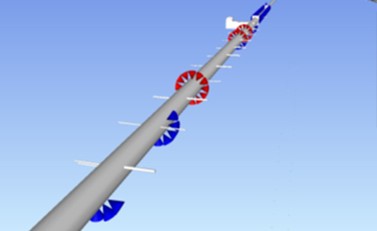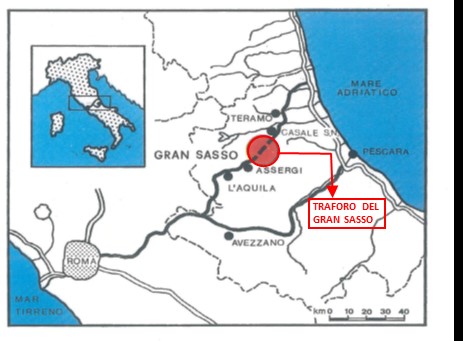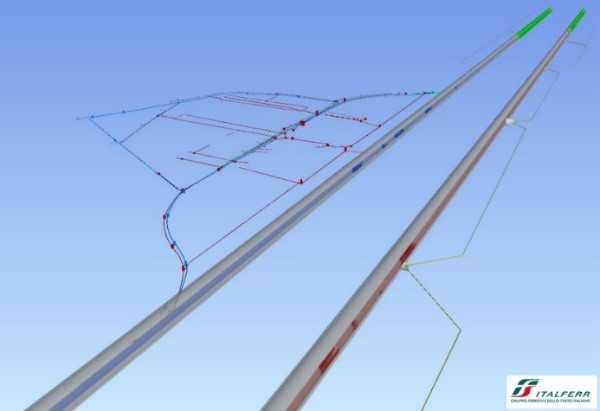AUTORE: Fabrizio Iezzi
TUTOR: Giovanni Franchi
MASTER: Master in “Project Management in Construction Works with BIM” a.a 2021/2022
Il presente lavoro di Tesi qualifica l’ambito operativo del Responsabile Unico del Procedimento (RUP) in uno specifico contesto applicativo ed esecutivo, con azioni ed attività finalizzate alla realizzazione di un intervento ingegneristicamente complesso ed unico per l’entità di spesa e per la particolare rilevanza dei luoghi interessati e degli attori coinvolti.
Trattasi infatti di intervento che interessa l’importante infrastruttura idraulica localizzata all’interno e al di sotto del piano viabile del Traforo autostradale del Gran Sasso (composto da n. 2 gallerie della lunghezza di circa 10 km cadauna sull’autostrada A24 Teramo-L’Aquila-Roma, avente carattere strategico-nazionale), frapposta tra le Province di L’Aquila e Teramo e a servizio di circa 700 mila abitanti (ovvero circa metà dell’intera popolazione dell’Abruzzo) (Figura 1). L’intervento medesimo interessa anche i Laboratori Nazionali del Gran Sasso (L.N.G.S.) dell’Istituto Nazionale di Fisica Nucleare (I.N.F.N.) localizzati nel nucleo roccioso del Massiccio del Gran Sasso, in adiacenza e con accesso diretto ed esclusivo dall’interno del Traforo autostradale medesimo (Figura 2). La spesa complessivamente stimata per l’intervento in programma è di Euro 160 milioni e il periodo di esecuzione è di circa 4 anni.
Le attività di programmazione, progettazione e gestione sin qui eseguite (periodo 2021/2022) sono state condotte nel rispetto del Codice dei Contratti Pubblici (D.Lgs. 50/2016) e della normativa vigente di settore, nonché nei limiti consentiti dalle deroghe specifiche assegnate al Commissario Straordinario preordinato all’intervento in questione (ex art. 4-ter del D.Lgs. 32/2019) e nominato con provvedimento governativo (DD.P.C.M. 05/11/2019 e 22/12/2021). In tale contesto è stata altresì data attuazione e valorizzazione alla metodologia BIM (Building Information Modeling) per la redazione del progetto di fattibilità tecnica ed economica (PFTE), da porre a base di gara per l’esecuzione dei lavori.
Richiamato che l’art. 31, co. 3, del D.Lgs. 50/2016 attribuisce al RUP il ruolo di figura professionale responsabile dello svolgimento di tutti i compiti relativi alla programmazione, progettazione, affidamento ed esecuzione dei contratti pubblici, ne consegue la sua diretta influenza sull’efficacia complessiva dell’azione commissariale ed il relativo riflesso sui risultati attesi.
Infatti, i successivi sviluppi normativi hanno attribuito a questa figura professionale compiti e responsabilità sempre più chiari e definiti, portandola ad essere equiparata ad un vero e proprio Project Manager nel settore degli appalti pubblici, figura mutuata dal settore privato, e sempre più importante e qualificante del buon funzionamento della Pubblica Amministrazione, diventata così fondamentale per gestire, coordinare e verificare il corretto operato di tutti i soggetti competenti e coinvolti nell’attività nel suo complesso.
A tal proposito, si ricorda che le Linee Guida ANAC n. 3/2016 di attuazione del D.Lgs. 50/2016 e ss.mm.ii., nel richiedere per il RUP una professionalità articolata, multidisciplinare e di elevato profilo che sia in grado di “creare le condizioni affinché il processo realizzativo risulti condotto in modo unitario in relazione ai tempi e ai costi preventivati, alla qualità richiesta, alla manutenzione programmata, alla sicurezza e alla salute dei lavoratori e in conformità a qualsiasi altra disposizione di legge in materia”, prevedono altresì che “il RUP dovrà possedere […] adeguata competenza quale Project Manager, acquisita anche attraverso la frequenza, con profitto, di corsi di formazione in materia di Project Management”.
Resta quindi confermato che le conoscenze, le abilità ed esperienze complesse e articolate richieste per il RUP dall’attuale normativa richiedono la formalizzazione di un modello aggiornato e integrato di competenze che possa garantire a tale ruolo il pieno ed efficace presidio tanto delle storiche attività a questi affidate di natura burocratica, amministrativa e normativa, quanto delle recenti responsabilità di governance dell’intero ciclo di vita del contratto pubblico, specificamente afferenti alle competenze di gestione di progetti e programmi (project, program e risk management) con particolare riferimento alle opere pubbliche.
A ciò è da aggiungere che il settore delle costruzioni, pure strategico nell’ambito dei programmi di sviluppo economico nazionali, sta vivendo un’evoluzione completa e una conseguente trasformazione organizzativa e tecnologica che spingono l’intero settore verso l’innovazione in ottica digitale. Il BIM quindi rappresenta e descrive l’effetto di questo cambiamento su processi, metodi organizzativi, strumenti e approcci gestionali.
Tale circostanza ha giocoforza un forte impatto anche sulla Pubblica Amministrazione, che rappresenta un attore importante nel settore delle costruzioni in quanto gestisce una quantità di edifici significativamente variegata, qualificata ed importante per consistenza e caratteristiche d’uso. Il ruolo del BIM nell’ambito della Pubblica Amministrazione è stato istituito e definito con il cosiddetto Decreto BIM (D.M. 560/2017 modificato dal D.M. 312/2021), stabilendo le modalità e i tempi di progressiva introduzione, da parte delle Stazioni Appaltanti, dei metodi e degli strumenti elettronici di modellazione per l’edilizia e le infrastrutture, come già introdotto dal Codice dei Contratti Pubblici (art. 23, co. 1, lett. h), del D.Lgs. 50/2016) ed acclarato anche nelle procedure di disciplina della Direzione dei Lavori (D.M. 49/2018).
Per completezza, si richiama altresì che il documento integrativo delle Linee Guida ANAC n. 1/2016, e successivi aggiornamenti, ha chiarito che tutti i soggetti interni alle Stazioni Appaltanti chiamati ad interfacciarsi con le attività connesse alla realizzazione dell’opera pubblica, dalla progettazione alla costruzione, devono avere adeguate competenze su tali metodi e strumenti elettronici e, per quanto sopra, il RUP è tra le principali figure coinvolte nell’applicazione della metodologia BIM.
È da considerare che oggi, tale metodologia BIM è tema di grande attualità, diffuso in campo ingegneristico, a carattere prevalentemente edilizio. Tuttavia, a tale proposito, non può essere trascurato che la sua applicazione ed estensione nell’ambito dell’ingegneria delle infrastrutture è ancora in corso di perfezionamento, attese le molteplici difficoltà che possono insorgere causa la complessità e varietà dei problemi emergenti e le conseguenti matrici e modellazioni coinvolti in fase informatica.
Al riguardo, il presente elaborato di Tesi riporta, inizialmente, l’introduzione storica della “questione del sistema idrico del Gran Sasso” e delle criticità che hanno reso necessario l’introduzione della figura straordinaria commissariale ex DD.P.C.M. 05/11/2019 e 22/12/2021, sostitutiva di quelle ordinarie (ministeriali, regionali, etc.). Prosegue con la rivisitazione normativa della figura del RUP: evoluzione della figura, competenze e responsabilità assegnategli nel tempo (ex L. 241/1990 e D.Lgs. 50/2016), equiparazione funzionale di Project Manager nel settore degli appalti pubblici (Linee Guida ANAC n. 3/2016). Richiama le generalità dei livelli di progettazione e la normativa BIM, integrandone i contenuti con l’esposizione delle deroghe normative istitutive del Commissario Straordinario ex DD.P.C.M. 05/11/2019 e 22/12/2021 e come queste sono state interpretate ed usate per la redazione del PFTE da porre a base di gara, mediante “appalto integrato”, da indire successivamente per l’esecuzione delle opere.
Successivamente, dopo la presentazione delle attività programmatiche del RUP in ambito economico-finanziario e il cronoprogramma associato ai relativi procedimenti/attività tecnico-amministrativi, l’elaborato in questione richiama gli appalti più significativi gestiti dello stesso RUP per la necessaria e preliminare definizione dello stato di fatto della infrastruttura acquedottistica interessata, riportato anche in BIM.
A questo punto, viene introdotto il PFTE redatto con l’ausilio della Società Italferr S.p.A. del Gruppo Ferrovie dello Stato individuata per lo svolgimento dei servizi tecnici di ingegneria a supporto della progettazione.
Al riguardo, vengono indicati le linee di progetto qualificanti l’intervento nel suo complesso, gli aspetti tecnici e gli obiettivi progettuali, i tempi di esecuzione ed i costi previsti riportati nel quadro economico di spesa.
In merito alla metodologia BIM utilizzata per il PFTE, vengono illustrate le tecnologie informatiche (hardware e software) di riferimento, i principali dati e le informazioni di base utilizzati per il data base della modellazione nonché il flusso dello sviluppo della progettazione e ed ogni altra informazione e descrizione sul BIM, ivi compresi l’ambiente di condivisione, la verifica e validazione dei modelli e degli elaborati utilizzati e realizzati.
Per ultimo, la Tesi mostra le immagini esemplificative dei modelli BIM (stato di fatto e di PFTE), per fornire una visione fisica dell’ambiente interessato (Figura 3). In merito allo stato di fatto, sono evidenziati i particolari e caratteristiche più significativi delle opere e dei manufatti con maggiore criticità (Figura 4); nel PFTE viene evidenziato il dettaglio dei singoli elementi della complessa infrastruttura in ogni aspetto tecnico, costruttivo e funzionale (Figure 5 e 6).

Figura 4: BIM Stato di Fatto – dettaglio perdite (“coni rossi”) e delle immissioni (“coni blu”) di acqua nella infrastruttura idraulica del Traforo del Gran Sasso
In conclusione ed in sintesi, il presente lavoro di Tesi, con riferimento al caso applicativo prescelto, ovvero il PFTE della messa in sicurezza del sistema idrico del Gran Sasso, ha mostrato la complessità dell’attività del RUP negli aspetti tecnici, amministrativi e gestionali, evidenziandone similitudini ed affinità con quella della figura del Project Manager propriamente detto, ma collocato ed operante nella Pubblica Amministrazione.
Inoltre, generalizzando i risultati emersi dalla progettazione in esame, è possibile affermare che il BIM permette di esplorare un sistema infrastrutturale complesso e dal suo interno, in tutti i suoi elementi/componenti, dati ed informazioni eterogenei ed interconnessi tra loro, nonché interagenti ed intercambiabili con la massima pronta interoperabilità necessaria per i fini di controllo e monitoraggio del sistema stesso, sia in fase di realizzazione che di successiva gestione.
Il BIM inoltre presenta i seguenti ulteriori punti di forza consentendo di:
- elevare lo standard delle scelte progettuali, attraverso la visualizzazione della modellazione tridimensionale, e favorire il concetto di progettazione integrata basata sul coinvolgimento di tutti gli attori della filiera;
- affinare i processi di coordinamento progettuale grazie all’utilizzo di una piattaforma di collaborazione e condivisione dati, in grado di garantire ovvero di facilitare l’accesso alle informazioni, nonché il loro scambio, a ciascun utente da qualsiasi luogo e garantendo la tracciabilità del processo di progettazione attraverso l’uso di un efficiente sistema revisionale;
- implementare le procedure volte all’integrazione di nuovi aspetti progettuali in un processo BIM-Oriented;
- sviluppare un gemello digitale dell’intera opera che integra al suo interno dati di natura differente;
- individuare eventuali conflitti (clash detection) nella progettazione;
- gestire e coordinare le fasi evolutive della progettazione
FOR INTERNATIONAL STUDENTS:
The present Master Thesis qualifies the operational scope of the Responsible for the Procedure (RP, in Italian so-called RUP) in a specific application and executive context, with actions and activities aimed at the execution of a complex and unique engineering work for the amount of cost and for the particular relevance of the places and the actors involved.
In fact, this is a work that interests the important hydraulic infrastructure located inside and below the road surface of the Gran Sasso highway Tunnel (composed of two tunnels with an extension of about 10 kilometers long each on the A24 Teramo-L’Aquila-Rome highway, with strategic-national nature in Italy) between the Provinces of L’Aquila and Teramo and at the service of about 700 thousand inhabitants (that is about half of the entire Abruzzo population) (Figure 1).
The work itself interests also the Gran Sasso National Laboratories of the National Institute of Nuclear Physics located in the rocky core of the Gran Sasso Mountain, adjacent and with direct and exclusive access from inside the highway Tunnel itself (Figure 2). The overall estimated cost for the planned work is of 160 millions and the execution period is about 4 years.
The planning, design and management activities performed up to now (period 2021/2022) have been conducted in accordance with the Italian Public Contracts Code (Italian Legislative Decree n. 50/2016) and current national sector legislation, as well as within the limits allowed by the specific derogations assigned to the Extraordinary Commissioner preordered to the work in question (according to the article 4-ter of Italian Legislative Decree n. 32/2019) and appointed by government order (Decrees of the President of the Italian Ministries Council of 05/11/2019 and of 22/12/2021).
In that context, the BIM (Building Information Modeling) methodology was also implemented and enhanced for the production of the technical and economic feasibility design, to be used as a basis for the tender for the execution of the works.
Recalled that the article 31, paragraph 3, of the Italian Legislative Decree n. 50/2016 attributes to RP the role of professional figure responsible for carrying out all tasks relating to the planning, design, assignment and execution of public contracts, it follows its direct influence on the overall effectiveness of the commissioner’s action and its related reflection on the expected results.
In fact, subsequent regulatory developments have attributed increasingly clear and defined tasks and responsibilities to this professional figure, leading the RP to be equated to a real Project Manager in the public procurement sector, figure borrowed from the private sector, and increasingly important and qualifying for the proper functioning of the Public Administration, become so essential to manage, coordinate and verify the correct work of all the competent subjects involved in the activity as a whole.
In this regard, please note that the Guidelines of Italian National Anti-Corruption Authority n. 3/2016 of implementation of the Italian Legislative Decree n. 50/2016, in requiring an articulated, multidisciplinary and high-profile professionalism for the RP that is able to “create the conditions for the realization process to be conducted in a unified manner in relation to the estimated times and costs, the required quality, scheduled maintenance, the safety and health of workers and in compliance with any other legal provision on the matter” these also contemplate that “the RUP must possess […] adequate competence as a Project Manager, also acquired through the attendance, with profit, of training courses on Project Management”.
It therefore remains confirmed that the complex and articulated knowledge, skills and experience required for the RP by current legislation require the formalization of an updated and integrated model of skills that can guarantee this role full and effective supervision of both the historical activities at these entrusted of a bureaucratic, administrative and regulatory nature, as well as the recent governance responsibilities of the entire life cycle of the public contract, specifically relating to project and program management skills (project, program and risk management) with particular reference to public works.
To this it should be added that the construction sector, although strategic in the context of Italian national economic development programs, is experiencing a complete evolution and a consequent organizational and technological transformation that pushes the entire sector towards innovation in a digital perspective. The BIM, therefore, represents and describes the effect of this change on processes, organizational methods, tools and management approaches.
This circumstance necessarily has a strong impact also on the Public Administration, which represents an important player in the construction sector as it manages a significantly varied, qualified and important quantity of buildings in terms of consistency and characteristics of use.
The role of BIM within the Public Administration was established and defined with the so-called BIM Decree (Italian Ministerial Decree n. 560/2017 modified by Italian Ministerial Decree n. 312/2021), establishing the methods and times for the progressive introduction, by the Contracting Stations, of and electronic modeling tools for construction and infrastructure, as already introduced by the Italian Code of Public Contracts (Article 23, paragraph 1, letter h), of Italian Legislative Decree n. 50/2016) and also ascertained in the procedures regulation of the Works Management (Italian Ministerial Decree n. 49/2018).
For the sake of completeness, it is also recalled that the supplementary document of the Guidelines of Italian National Anti-Corruption Authority n. 1/2016, and subsequent updates, clarified that all subjects internal to the Contracting Stations called to interface with the activities related to the implementation of the public work, from design to construction, must have adequate skills on these methods and electronic tools and, for the above, the RP is among the main figures involved in the application of the BIM methodology.
It should be considered that today, this BIM methodology is a very topical issue, widespread in the engineering field, mainly of a building nature. However, in this regard, it cannot be overlooked that its application and extension in the field of infrastructure engineering is still being perfected, given the many difficulties that may arise due to the complexity and variety of emerging problems and the consequent matrices and modeling involved in the computer stage.
In this regard, this Thesis work initially reports the historical introduction of the “question of the Gran Sasso water system” and the critical issues that made it necessary to introduce the Extraordinary Commissioner figure (appointed by Decrees of the President of the Italian Ministries Council of 05/11/2019 and of 22/12/202), replacing the ordinary ones (ministerial, regional, etc.). It continues with the Italian regulatory review of the figure of the RP: evolution of the figure, skills and responsibilities assigned to him over time (Italian Law n. 241/1990 and Italian Legislative Decree n. 50/2016), functional equivalence of Project Manager in the Public Procurement sector (Guidelines of Italian National Anti-Corruption Authority n. 3/2016). It recalls the generalities of the design levels and the BIM legislation, integrating its contents with the exposition of the regulatory derogations establishing the Extraordinary Commissioner (appointed by Decrees of the President of the Italian Ministries Council of 05/11/2019 and of 22/12/202) and how these have been interpreted and used for the preparation of the design of technical and economic feasibility to be used as a basis for the tender, by means of an “integrated contract”, to be called subsequently for the execution of the works.
Subsequently, after the presentation of the programmatic activities of the RP in the economic-financial field and the time schedule associated with the related technical-administrative procedures/activities, the Thesis work refers to the most significant contracts managed by the same RP for the necessary and preliminary definition of the actual state of the aqueduct infrastructure concerned, also reported in the BIM.
At this point, it is introduced the technical and economic feasibility design drawn up with the help of Company Italferr S.p.A. of the Italian State Railway Group identified for the performance of technical engineering services to support the design.
In this regard, the design lines qualifying the intervention as a whole, the technical aspects and the design objectives, the execution times and the expected costs reported in the economic framework of expense are indicated.
With regard to the BIM methodology used for the technical and economic feasibility design, the computer technologies (hardware and software) of reference are illustrated, the main data and basic information used for the modeling database as well as the flow of design development and any other information and description on the BIM, including the sharing environment, verification and validation of the models and documents used and created.
Finally, the Thesis work shows the exemplary images of the BIM models (actual state and technical and economic feasibility design), to provide a physical view of the environment concerned (Figure 3). With regard to the state of affairs, the most significant details and characteristics of the most critical works and artifacts are highlighted (Figure 4); the technical and economic feasibility design highlights the detail of the individual elements of the complex infrastructure in every technical, constructive and functional aspect (Figures 5 and 6).
In conclusion and in summary, this Thesis work, with reference to the chosen application case, i.e. the technical and economic feasibility design of the safety of the Gran Sasso water system, has shown the complexity of the RP’s activity in the technical, administrative and management aspects, highlighting similarities and affinities with that of the figure of the Project Manager proper, but placed and operating in the Public Administration.
Furthermore, generalizing the results that emerged from the design in question, it is possible to state that BIM makes it possible to explore a complex infrastructural system and from within it, in all its elements/components, heterogeneous and interconnected data and information, as well as interacting and interchangeable with the maximum ready interoperability necessary for the purposes of control and monitoring of the system itself, both in the construction phase and in subsequent management.
BIM also has the following additional strengths, allowing to:
- raise the standard of design choices, through the visualization of three-dimensional modeling, and promote the concept of integrated design based on the involvement of all players in the supply chain;
- refine the design coordination processes thanks to the use of a collaboration and data sharing platform, capable of guaranteeing or facilitating access to information, as well as their exchange, to each user from any location and guaranteeing the traceability of the design process through the use of an efficient revision system;
- implement the procedures aimed at integrating new design aspects into a BIM-Oriented process;
- develop a digital twin of the entire work that integrates data of a different nature within it;
- identify any conflicts (clash detection) in the design;
- manage and coordinate the evolutionary phases of the design.






